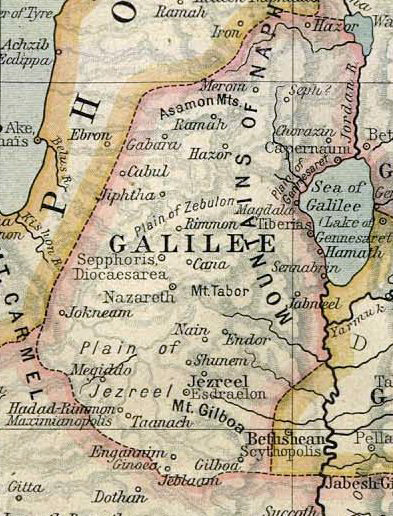What is…
Galilee
Hebrew: הגליל —transliteration: HaGalil or Galilee
Meaning: circuit
also known as: Galil, Jalīl, Cabul

This is a northern region of ancient Canaan and Israel. Its first mention in Scripture is under the Hebrew name גָּלִיל (transliteration: Galil) in Joshua 20:7.
King Solomon rewarded King Hiram, for services rendered in building Solomon’s Temple, with the gift of an upland plain among the mountains of the Tribe of Naphtali. Hiram was dissatisfied with the gift, and called it “the land of Cabul.” The Jews called it Galil.
It continued to be occupied for many years by the original inhabitants. Eventually the Israelites called it “Galilee of the Gentiles” (Matthew 4:15), and also “Upper Galilee,” to distinguish it from the extensive addition afterwards made to it toward the south, which was usually called “Lower Galilee.”
In the time of our Lord, Galilee embraced more than ⅓ of Western Israel, extending “from Dan on the north, at the base of Mount Hermon, to the ridges of Carmel and Gilboa on the south, and from the Jordan valley on the east away across the splendid plains of Jezreel and Acre to the shores of the Mediterranean on the west.”
The land of Israel was divided into three provinces, Judea, Samaria, and Galilee, which comprehended the whole northern section of the country (Acts 9:31), and was the largest of the three. It was the scene of some of the most memorable events of Jewish history.
Galilee also was the home of our Lord during at least 30 years of his life. The first 3 Gospels are mainly about with our Lord’s public ministry in this province.
“The entire province is encircled with a halo of holy associations connected with the life, works, and teachings of Jesus of Nazareth.”
“It is noteworthy that of his 32 beautiful parables, no less than 19 were spoken in Galilee. And it is no less remarkable that of his entire 33 great miracles, 25 were wrought in this province.
His first miracle was wrought at the wedding in Cana of Galilee, and his last, after his resurrection, on the shore of Galilee’s sea.
“In Galilee, our Lord delivered the Sermon on The Mount, and the discourses on ‘The Bread of Life,’ on ‘Purity,’ on ‘Forgiveness,’ and on ‘Humility.’
In Galilee, he called his first disciples; and there occurred the sublime scene of the Transfiguration” (Porter’s Through Samaria).
When the Sanhedrin were about to proceed with some plan for the condemnation of our Lord (John 7:45-52), Nicodemus interposed in his behalf. (Compare Deuteronomy 1:16,17; 17:8.) They replied, “Art thou also of Galilee?… Out of Galilee ariseth no prophet.”
This saying of theirs was “not historically true, for 2 prophets, at least, had arisen from Galilee, Jonah of Gath-hepher, and the greatest of all the prophets, Elijah… and perhaps also Nahum and Hosea. Their contempt for Galilee made them lose sight of historical accuracy” (Henry Alford commentary).
The Galilean accent differed from that of Jerusalem in being broader and more guttural (Mark 14:70).
More information
- Galilean
- Sea of Galilee
- Tribe of Naphtali
- Ahlab—northwest of the Sea of Galilee
- Andrew, the apostle—from Bethsaida in Galilee
- Herod Antipas (aka Antipas)—tetrarch of Galilee during Christ’s ministry
- Aphek—city east of Sea of Galilee
- Cabul—a district in Galilee
- Cana—a town of Galilee
- Chinnereth—a city and district in Galilee
- Dalmanutha (aka Magdala)—a place on the west of the Sea of Galilee
- Decapolis—a 10 city district on the east and southeast of the Sea of Galilee
- Elkosh—birthplace of Nahum
- Gadara—a city
- Gath-hepher—a city (birthplace of Jonah)—in Galilee
- Gaulanitis—a city of refuge and province
- Gennesaret
- Gergesa
- Golan
- Harosheth of the Gentiles
- Hittites
- Jesus
- John the apostle
- Joseph, the adoptive-father of Jesus Christ
- Nazareth
- Judas of Galilee, founder of the Zealots
- Miracles of the Bible
